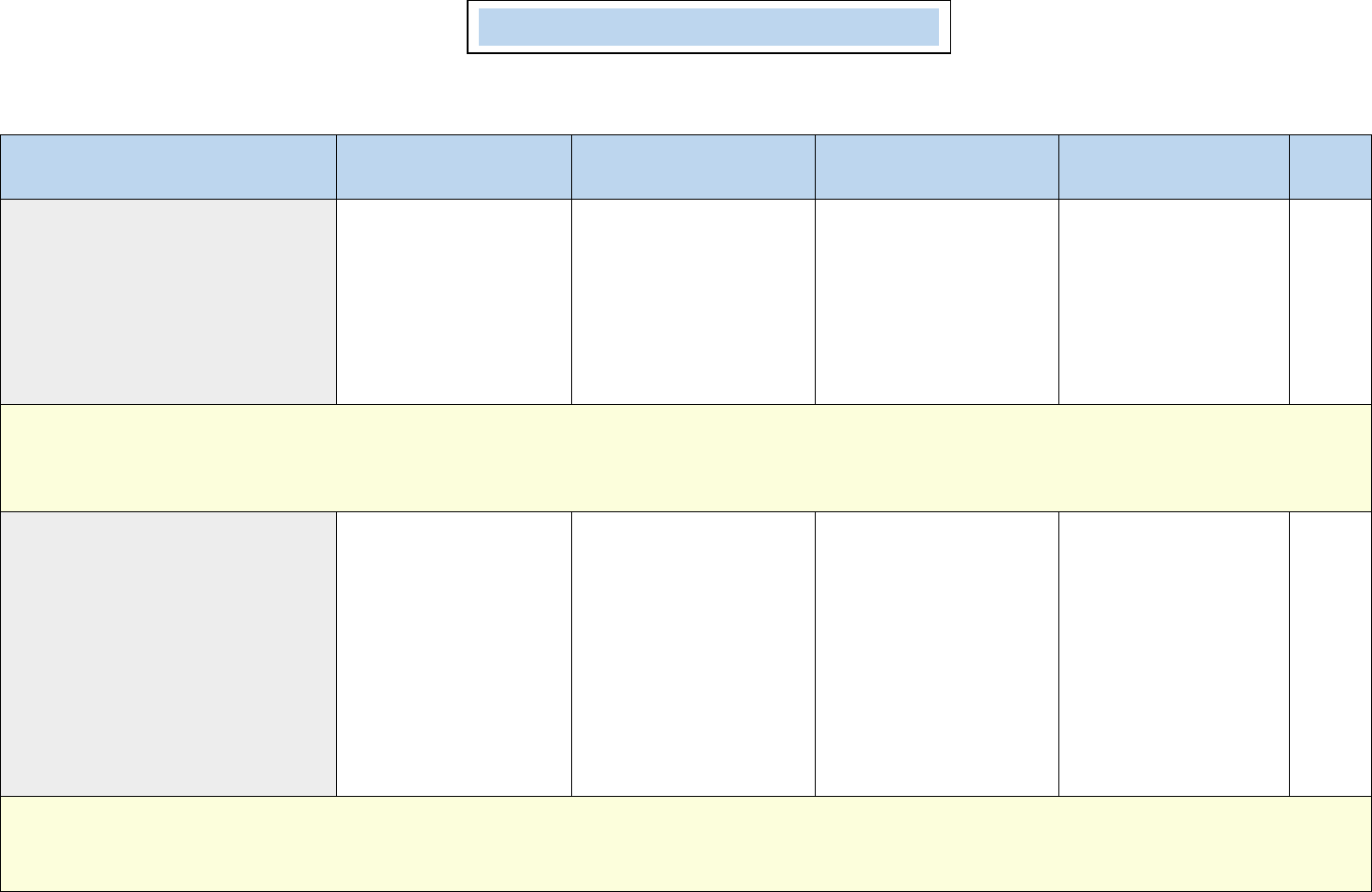
OCC-Workforce Advancement Branch – Training Proposal Evaluation Rubric
Page 1 of 9
✓ Directions and Guidance:
Carefully review the training proposal package and use the attached scoring rubric to evaluate the proposal. (Updated May 2023)
Read each indicator description carefully and check the box (score 0-5) that matches your assessment of the proposal.
Do not mark in between scores (example 3.5).
Score exceptional indicators with a 5.
It is required that Reviewers provide a justification for a score of 0 or 3 within the comment section below each criterion within the
designated category. Please include recommendations on how the applicant can improve the Training Proposal.
Total the scores within each category under “Organization, Content, and Presentation.”
Record the category totals in the spaces provided below.
Training Proposals must meet a minimum score of 80 to be approved.
Title of the proposed training: _________________________________________________________________________________________
Print name of Peer Reviewer:
I, __________________________________, have carefully evaluated the training proposal using the criteria established in the evaluation rubric.
As the peer reviewer I am including my signature _________________________________ and the date______________ of the completed rubric.
Category Scores
Organization: ______/30
Content: ______/45
Presentation: ______/25
Total Score: _______/100
Training Proposal Evaluation Rubric (Cover)

OCC-Workforce Advancement Branch – Training Proposal Evaluation Rubric
Page 2 of 9
ORGANIZATION
ORGANIZATION
CRITERIA
0
3
4
5
SCORE
Written materials including
handouts, PowerPoint slides,
trainer note pages, planning
template, etc., use quality
writing, grammar, spelling, and
mechanics.
The training proposal is
very poorly written and
has 6 or more errors in
grammar, spelling, and
mechanics.
The training proposal
has 3 -5 errors in
grammar, spelling, and
mechanics.
The training proposal
has 1 – 2 errors
grammar, spelling, and
mechanics.
The training proposal
is very clearly written
with no errors in
grammar, spelling, and
mechanics.
Comments:
Written materials including
PowerPoint slides, handouts,
etc., are consistent with ADA
approved font style, size, color,
bullet points, slide numbers,
readability.
Written materials
including PowerPoint
slides, handouts etc.,
do not meet any of the
criteria (ADA approved
font style, size, color,
bullet points, slide
numbers, readability).
Written materials
including PowerPoint
slides, handouts, etc.,
meet 3 of the 6 criteria:
(e.g. ADA approved font
style, size, color, bullet
points, slides numbers,
and readability).
Written materials
including PowerPoint
slides, handouts, etc.,
meet 4 of the 6 criteria:
(e.g. ADA approved font
style, size, color, bullet
points, slides numbers,
and readability).
Written materials
including PowerPoint
slides, handouts, etc.,
meet all 6 criteria:
(e.g. ADA approved
font style, size, color,
bullet points, slides
numbers, and
readability).
Comments:
Training Proposal – Scoring Rubric

OCC-Workforce Advancement Branch – Training Proposal Evaluation Rubric
Page 3 of 9
Maintains consistency
throughout the training proposal
description, learning objectives,
content, and methods.
Fewer than 2 of the 4
criteria are consistent
with one another
(training proposal
description, learning
objectives, content,
and methods).
2 of the 4 criteria are
consistent with one
another (training
proposal description,
learning objectives,
content, and methods).
3 of the 4 criteria are
consistent with one
another (training
proposal description,
learning objectives,
content, and methods).
All 4 criteria are
consistent with one
another (training
proposal description,
learning objectives,
content, and
methods).
Comments:
Specifies realistic and measurable
learning objectives (minimum of
3; maximum of 5, and each aligns
with a competency identifier).
None of the learning
objectives are realistic,
written in measurable
terms, and align with a
competency identifier.
Some of the learning
objectives are realistic,
written in measurable
terms, and each aligns
with a competency
identifier.
Most of the learning
objectives are realistic,
written in measurable
terms, and each aligns
with a competency
identifier.
All the learning
objectives are realistic,
written in measurable
terms, and each aligns
with a competency
identifier.
Comments:
A minimum of 3
References/Resources cited are
reputable, published within 5-7
years, from multiple source
types, and appropriate for use as
the foundation of training
content. All handouts, videos,
and documents are listed.
None of the sources
cited are reputable,
published within 5-7
years, and appropriate
for use as the
foundation of training
content. None of the
handouts, videos, and
documents are listed.
One of the sources cited
is reputable, published
within 5-7 years, and
appropriate for use as
the foundation of
training content. Some
handouts, videos, and
documents are listed.
Two of the sources cited
are reputable, published
within 5-7 years, and
appropriate for use as
the foundation of
training content. Most
handouts, videos, and
documents are listed.
Three of the sources
cited are reputable,
published within 5-7
years, and appropriate
for use as the
foundation of training
content. All handouts,
videos, and documents
are listed.

OCC-Workforce Advancement Branch – Training Proposal Evaluation Rubric
Page 4 of 9
Comments:
Timeline allots adequate time for
content, activities, assessment,
and evaluation (excluding
breaks).
Timeline allotted for
content, activities,
assessment, and
evaluation is not at all
adequate.
Timeline allotted for
content, activities,
assessment, and
evaluation is somewhat
adequate.
Timeline allotted for
content, activities,
assessment, and
evaluation is adequate.
Timeline allotted for
content, activities,
assessment, and
evaluation is clearly
adequate.
Comments:
Organization Category Total Score
/30
Overall Comment for Organization:

OCC-Workforce Advancement Branch – Training Proposal Evaluation Rubric
Page 5 of 9
CONTENT
CONTENT
CRITERIA
0
3
4
5
SCORE
Training Title is strength-based
and appropriately refers to the
subject(s) of the training.
Training title is not
strength-based.
Training title uses
strength-based
language but does very
little to appropriately
refer to the subject(s) of
the training.
Training title uses
strength-based language
and somewhat
appropriately refers to
subject(s) of the training.
Training title uses
strength-based
language and
appropriately refers to
the subject(s) of the
training.
Comments:
Training Description clearly
explains the content of the
training, the need for the
training, and the benefits to the
participants.
Training description
does not explain the
content of the training,
the need for the
training, and the
benefits to the
participants.
Training description
somewhat explains the
content of the training,
the need for the
training, and the
benefits to the
participants.
Training description
explains the content of
the training, the need for
the training, and the
benefits to the
participants.
Training description
clearly explains the
content of the training,
the need for the
training, and the
benefits to the
participants.
Comments:
Training proposal provides
clearly sufficient information
specific to training content and
objectives.
Training proposal does
not provide sufficient
information specific to
training content and
objectives.
Training proposal
provides somewhat
sufficient information
specific to training
content and objectives.
Training proposal
provides sufficient
information specific to
training content and
objectives.
Training proposal
provides clearly
sufficient information
specific to training
content and objectives.
Comments:

OCC-Workforce Advancement Branch – Training Proposal Evaluation Rubric
Page 6 of 9
Incorporates learning objectives
and methods to measure
learning.
Less than 50% of the
learning objectives and
methods to measure
learning are addressed
in the content.
At least 50% of the
learning objectives and
methods to measure
learning are addressed
in content.
At least 75% of the
learning objectives and
methods to measure
learning are addressed in
content.
All the learning
objectives and methods
to measure learning are
addressed in content.
Comments:
Addresses special needs such as
adaptations, modifications,
inclusionary practices, person
first language, and ADA
guidelines for both the
participants and the population
they serve.
Training content does
not address special
needs such as
adaptations,
modifications,
inclusionary practices,
person first language,
and ADA guidelines.
Special needs such as
adaptations,
modifications,
inclusionary practices,
person first language,
and ADA are addressed
in 5% of the content
and is explained in the
trainer notes.
Special needs such as
adaptations,
modifications,
inclusionary practices,
person first language,
and ADA are addressed
in 10% of the content
and is explained in the
trainer notes.
Special needs such as
adaptations,
modifications,
inclusionary practices,
person first language,
and ADA are addressed
in 20% of the content
and is explained in the
trainer notes.
Comments:
Addresses cultural sensitivity
and diversity for both the
participants and the population
they serve.
Training content does
not address cultural
sensitivity and
diversity.
Cultural sensitivity and
diversity are addressed
in 5% of the content
and are explained in the
trainer notes.
Cultural sensitivity and
diversity are addressed
in 10% of the content
and are explained in the
trainer notes.
Cultural sensitivity and
diversity are addressed
in 20% of the content
and are explained in
the trainer notes.
Comments:
Addresses housing insecurity
for both the participants and
the population they serve.
Training content does
not address housing
insecurity for both the
participants and the
population they serve.
Housing insecurity is
addressed in 2% of the
content and is explained
in the trainer notes.
Housing insecurity is
addressed in 5% of the
content and is explained
in the trainer notes.
Housing insecurity is
addressed in 10% of the
content and is
explained in the trainer
notes.

OCC-Workforce Advancement Branch – Training Proposal Evaluation Rubric
Page 7 of 9
Comments:
Addresses the targeted Core of
Knowledge area(s).
Content does not
match the targeted
Core of Knowledge
area(s).
At least 50% of the
content addresses the
targeted Core of
Knowledge area(s).
At least 75% of the
content addresses the
targeted Core of
Knowledge area(s).
All of the content
addresses the targeted
Core of Knowledge
area(s).
Comments:
Reflects current national
standards/guidelines, COMAR
regulations, best practices for
early care and education, and is
appropriate to content and
learning objectives.
Content does not
reflect current national
standards/guidelines,
COMAR regulations,
best practices for early
care and education,
and is appropriate to
content and learning
objectives.
(Must meet 5 in this
area)
(Must meet 5 in this
area)
Content reflects current
national
standards/guidelines,
COMAR regulations,
best practices for early
care and education,
and is appropriate to
content and learning
objectives.
Comments:
Content Category Total Score
/45
Overall Comment for Content:

OCC-Workforce Advancement Branch – Training Proposal Evaluation Rubric
Page 8 of 9
PRESENTATION
PRESENTATION
CRITERIA
0
3
4
5
SCORE
Provides quality materials and
handouts that are appropriate,
“user-friendly,” and include
reference information.
Training
materials/handouts are
inappropriate,
unprofessional, not
“user-friendly,” and
lacks reference
information.
Training
materials/handouts are
somewhat appropriate,
“user-friendly,”
professional but do not
have appropriate
reference information.
Most of the training
materials/handouts are
appropriate, “user-
friendly,” professional,
and include reference
information.
All the training
materials/handouts
are appropriate,
“user-friendly,”
professional, and
include reference
information.
Comments:
Content and methods of the
presentation are clearly
appropriate for the topic and
length of the training (example: the
number of PowerPoint slides and
amount of information contained
in each slide).
Content and methods
of the presentation are
not appropriate for the
topic and length of the
training.
Content and methods
of the presentation are
somewhat appropriate
for the topic and length
of the training.
Content and methods
of the presentation are
appropriate for the
topic and length of the
training.
Content and methods
of the presentation
are clearly
appropriate for the
topic and length of
the training.
Comments:
Presentation and/or PowerPoint
slides include the objectives and
summary/wrap-up.
Presentation and/or
PowerPoint slides do
not include the
objectives and
summary/wrap-up.
(Must meet 5 in this
area)
(Must meet 5 in this
area)
Presentation and/or
PowerPoint slides
include the objectives
and summary/wrap-
up.
Comments:

OCC-Workforce Advancement Branch – Training Proposal Evaluation Rubric
Page 9 of 9
Training content clearly connects to
practical application and meets the
needs of participants.
Practical application is
not linked to content
and does not meet the
needs of participants.
Practical application is
somewhat linked to
content and the needs
of participants.
Practical application is
linked to content and
the needs of
participants.
Practical application is
clearly linked to
content and meets
the needs of
participants.
Comments:
Methods of delivery clearly reflect
a variety of learning styles, are
appropriate for adult learners, and
promote active learning.
Delivery methods do
not reflect a variety of
learning styles, are not
appropriate for adult
learners, and do not
promote active
learning.
Delivery methods
somewhat reflect a
variety of learning
styles, are somewhat
appropriate for adult
learners, and
somewhat promote
active learning.
Delivery methods
reflect a variety of
learning styles, are
appropriate for adult
learners, and promote
active learning.
Methods of delivery
clearly reflect a
variety of learning
styles, are
appropriate for adult
learners, and
promote active
learning.
Comments:
Presentation Category Score
/25
Overall Comment for Presentation:
